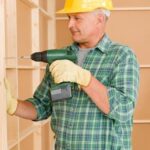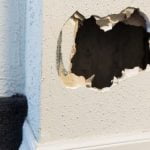The rising concern about environmental sustainability and reducing energy consumption in households has prompted a growing interest in energy-efficient home improvements. As individuals become more aware of their carbon footprint and the need to combat climate change, investing in energy efficiency has become a top priority for many homeowners. Energy-efficient home improvements play a crucial role in minimizing both environmental impact and monthly utility bills.
So what exactly qualifies as energy efficient home improvements? Defined as upgrades that increase the overall energy efficiency of a house, these improvements can range from simple modifications to more substantial renovations. Examples include adding insulation to minimize heat loss or gain, installing energy-efficient windows and doors to optimize temperature control, and incorporating smart thermostats to regulate heating and cooling systems efficiently.
Not only do these enhancements result in significant cost savings on utility bills, but they also contribute to reducing greenhouse gas emissions. By decreasing energy consumption, homeowners are actively combating climate change and promoting a more sustainable future. With the benefits of energy efficiency becoming increasingly apparent, it is essential for individuals to explore the different options available to make their homes as environmentally friendly as possible.
What are Energy Efficient Home Improvements?
Energy efficient home improvements refer to upgrades and modifications made to residential properties that aim to reduce energy consumption and enhance overall energy efficiency. These improvements are designed to minimize the carbon footprint of homes, aligning with the growing concern for environmental sustainability. By making these upgrades, homeowners can not only save money on their monthly utility bills but also contribute to reducing greenhouse gas emissions and combating climate change.
One common example of an energy efficient home improvement is insulation. Proper insulation helps prevent air leakage, keeping warm or cool air inside the home depending on the season. This reduces the reliance on heating and cooling systems, resulting in significant energy savings.
Another popular upgrade is replacing old or inefficient windows with energy-efficient ones. These windows have improved thermal performance, minimizing heat loss during winter and heat gain during summer. Consequently, homeowners can optimize their indoor temperature without relying too heavily on HVAC systems.
In recent years, technology has played a significant role in improving energy efficiency at home. Smart thermostats are becoming increasingly popular as they allow homeowners to remotely control their heating and cooling settings based on their schedule and occupancy patterns. These devices learn user preferences over time, further optimizing energy usage within the home. Other examples include LED lighting fixtures that consume less electricity than traditional incandescent lights and high-efficiency appliances that conserve water and electricity.
Overall, energy efficient home improvements encompass a wide range of upgrades that target different areas within a residence to maximize energy conservation and decrease environmental impact. By understanding what these improvements entail, homeowners can make informed decisions about which upgrades will be most beneficial for their particular property.
The Benefits of Energy Efficient Home Improvements
Energy efficient home improvements offer a range of benefits, making them an attractive option for homeowners looking to reduce their environmental impact and save money on utility bills.
- Cost savings: One of the most appealing benefits of energy efficient home improvements is the potential for significant cost savings. Upgrading insulation, windows, and HVAC systems can help reduce energy consumption and lower monthly utility bills. For example, installing proper insulation in walls and attics can prevent heat loss during the winter and keep homes cooler in the summer, resulting in reduced heating and cooling costs.
Similarly, energy-efficient windows can minimize heat transfer, preventing drafts and reducing the need for excessive heating or air conditioning. High-efficiency HVAC systems use less energy to achieve the same level of comfort, leading to further savings on utility bills. - Environmental impact: Energy efficient home improvements also play a crucial role in reducing greenhouse gas emissions and combating climate change. By consuming less energy, homes with energy-efficient upgrades reduce the demand for fossil fuels used to generate electricity.
This leads to a decrease in carbon dioxide emissions from power plants that contribute to global warming. Additionally, energy-efficient homes often rely on renewable energy sources such as solar panels or wind turbines, further reducing reliance on fossil fuels and promoting sustainable living. - Comfort and health benefits: In addition to cost savings and environmental impact, energy efficient home improvements also offer improved comfort and health benefits. Proper insulation helps maintain consistent temperature levels throughout a house, minimizing uncomfortable hot or cold spots. Energy-efficient windows can reduce noise pollution by acting as effective sound barriers. Moreover, these improvements often result in better indoor air quality by preventing outdoor pollutants from entering the house through leaks or drafts.
Overall, investing in energy efficient home improvements provides a wide array of benefits ranging from financial savings to environmental sustainability and improved well-being within your living space.
Common Types of Energy Efficient Home Improvements
When it comes to making your home more energy-efficient, there are several types of improvements that can have a significant impact. These upgrades not only help reduce your carbon footprint but also lead to cost savings on your monthly utility bills. Here are some common types of energy-efficient home improvements that can make a difference:
Insulation
Proper insulation is one of the most essential aspects of attaining energy efficiency in your home. Insulation helps to create a thermal barrier, preventing heat transfer between the interior and exterior of your home. This means that during hot summer months, insulation keeps the cool air inside and the hot air outside, and vice versa during colder months.
There are different types of insulation available, including fiberglass, cellulose, and spray foam insulation. The choice depends on various factors such as budget, climate, and specific needs of your home. Investing in quality insulation can lead to significant energy savings by reducing the need for excess heating or cooling.
Windows and Doors
Energy-efficient windows and doors play a vital role in minimizing heat loss or gain within your home. Traditional windows and doors often allow drafts or thermal transfer due to poor seals or single-pane glass. Upgrading to windows with double or triple glazing, low-emissivity coatings, and insulated frames can greatly improve energy efficiency.
In addition to upgrading windows themselves, ensuring proper installation with weather stripping around frames and applying caulk where necessary will further help prevent drafts. Similarly, replacing old doors with well-insulated ones equipped with weatherstripping will contribute to maintaining an energy-efficient home.
Heating, Ventilation, and Air Conditioning (HVAC) Systems
The type and condition of your HVAC system significantly impact its energy efficiency. Older systems tend to be less efficient compared to newer models that meet higher standards for energy performance. High-efficiency HVAC systems can make a noticeable difference in reducing energy consumption and lowering utility bills.
Regular maintenance of the HVAC system is also crucial for optimal performance. Changing filters regularly, cleaning vents, and scheduling professional inspections can ensure that your heating and cooling system operates efficiently and consumes less energy.
By investing in these common types of energy-efficient home improvements, homeowners can greatly improve their home’s energy performance, reduce utility bills, and contribute to environmental sustainability. These upgrades not only make homes more comfortable but also help combat climate change by reducing greenhouse gas emissions.
Renewable Energy Systems
Renewable energy systems, such as solar panels and wind turbines, have emerged as a revolutionary solution in the pursuit of energy efficiency. These systems utilize natural resources that are constantly replenished, making them an environmentally friendly alternative to traditional energy sources. Incorporating renewable energy into homes can significantly enhance their energy efficiency and contribute to a more sustainable future.
One example of a widely used renewable energy system is solar panels. Solar panels harness the power of sunlight and convert it into electricity, which can be used to power various appliances and devices in a home. By generating electricity from the sun’s rays, homeowners can reduce or even eliminate their reliance on fossil fuels, resulting in decreased carbon emissions.
Another renewable energy system that can be implemented at home is wind turbines. Wind turbines convert the kinetic energy of the wind into electricity through the rotation of large blades. They are particularly beneficial for homes located in areas with consistent wind patterns. By harnessing wind power, homeowners can generate clean electricity without contributing to air pollution or greenhouse gas emissions.
Incorporating renewable energy systems into homes offers numerous benefits beyond enhanced energy efficiency. One key advantage is the potential for cost savings. While the upfront investment for installing these systems may be higher than traditional methods, over time, homeowners can experience significant reductions in their monthly utility bills. Additionally, depending on their location and local regulations, homeowners may also have the opportunity to sell excess electricity generated by their renewable energy systems back to the grid, further offsetting costs.
Furthermore, integrating renewable energy sources into homes has a positive environmental impact by reducing greenhouse gas emissions and combating climate change. Traditional fossil fuel-based electricity generation releases carbon dioxide and other pollutants into the atmosphere, contributing to global warming and air pollution. By transitioning to renewable energy systems, homeowners can play an active role in minimizing these harmful effects on our planet.
Overall, incorporating renewable energy systems into homes is a game-changer in terms of energy efficiency. It not only reduces reliance on finite resources but also promotes sustainability and cost savings. As technology continues to advance, renewable energy systems are becoming more accessible and affordable for homeowners, making them an excellent option for those looking to improve their home’s energy efficiency and make a positive impact on the environment.
Government Incentives and Programs for Energy Efficient Home Improvements
Government incentives and programs play a crucial role in encouraging homeowners to invest in energy-efficient home improvements. These initiatives are aimed at making energy-efficient upgrades more affordable and accessible, ultimately helping individuals reduce their carbon footprint and save on utility bills.
Tax credits, rebates, and financial incentives
One of the primary ways governments support energy efficiency is by offering tax credits, rebates, and various financial incentives to homeowners who make qualifying improvements. These incentives can range from federal or state tax credits to cash rebates offered by local utility companies. Homeowners can take advantage of these programs to offset the initial costs of energy-efficient upgrades and recoup some of their investment over time.
Energy-efficiency programs and initiatives
In addition to offering financial incentives, many governments also provide comprehensive energy-efficiency programs and initiatives. These programs are designed to educate homeowners about the benefits of energy efficiency and guide them through the process of making upgrades. They often include resources such as online tools for calculating potential cost savings, contractor directories for finding qualified professionals, and information on available rebates or financing options.
These government-sponsored programs may also offer energy assessments or audits that help homeowners identify areas for improvement in their homes. By partnering with local organizations or contractors, they ensure that homeowners receive expert advice specific to their region’s climate and building codes.
The impact of government initiatives
Government incentives and programs have been successful in incentivizing homeowners to adopt energy-efficient practices. By reducing the upfront costs associated with upgrades, these initiatives make it more attractive for individuals to invest in measures such as insulation upgrades, high-efficiency HVAC systems, or renewable energy installations.
Furthermore, these programs contribute directly to national sustainability goals by promoting reduced greenhouse gas emissions and addressing climate change. The cumulative effect of numerous households adopting energy-efficient practices can lead to significant environmental benefits on a larger scale.
DIY vs. Professional Installation
One important consideration when it comes to energy efficient home improvements is whether to opt for DIY installation or hire professionals. Both options have their advantages and disadvantages, and homeowners need to carefully evaluate which approach is best for their specific situation.
DIY installation can be an appealing option for those who are comfortable working with tools and have some experience in home improvement projects. One of the main advantages of DIY is cost savings. By avoiding labor costs, homeowners can significantly reduce the overall expense of energy-efficient upgrades. Additionally, some people find satisfaction and a sense of accomplishment in completing these projects themselves.
However, DIY installation also comes with potential drawbacks. First and foremost, it requires a certain level of knowledge and skill to ensure that the installations are done correctly and efficiently. Improperly installed insulation or windows, for example, may not provide the desired level of energy efficiency or performance. Furthermore, DIY installations may not be covered under warranty or may void existing warranties on products, which can be problematic if issues arise later on.
On the other hand, hiring professionals for energy-efficient home improvements offers several benefits as well. Experienced contractors have the expertise necessary to assess a home’s specific needs and recommend the most suitable upgrades. They can ensure that installations meet all building codes and regulations, increasing the likelihood of achieving optimal energy efficiency.
Moreover, professional installation often comes with warranties or guarantees on materials and workmanship. If something goes wrong down the line, homeowners have recourse for addressing any issues that arise without having to shoulder additional expenses.
It’s important to note that while professional installation generally ensures high-quality workmanship and reliable performance, it does come at a higher cost compared to DIY projects. Homeowners should consider their budgetary constraints when deciding between DIY or professional installations.
Overall, there is no one-size-fits-all answer to whether DIY or professional installation is best for energy-efficient home improvements. It ultimately depends on factors such as personal skills, budget limitations, and the complexity of the project. It is recommended to consult with professionals or conduct thorough research before making a decision to ensure that the chosen installation method aligns with individual needs and goals for energy efficiency.
| DIY Installation | Professional Installation |
|---|---|
| Cost savings | Expertise and experience |
| Potential warranty issues | Warranty or guarantees for materials and workmanship |
| Variability in quality of workmanship | Complies with building codes and regulations |
How to Determine if Your Home Qualifies for Energy Efficient Improvements
Assessing the current energy performance of your home is an important first step in determining whether it qualifies for energy-efficient improvements. This assessment can be done through an energy audit, which evaluates the overall energy consumption and identifies areas where improvements can be made.
During an energy audit, a professional will conduct a comprehensive evaluation of your home’s insulation, windows and doors, heating, ventilation, and air conditioning (HVAC) systems, as well as other factors that contribute to energy efficiency. They may use specialized equipment such as thermal imaging cameras to detect heat loss or gain in certain areas of your home.
Factors to consider when determining eligibility for energy-efficient upgrades include:
- Age and condition of your home: Older homes may have less efficient insulation and outdated HVAC systems, making them prime candidates for improvements.
- Current level of insulation: Insufficient or poorly installed insulation can contribute to significant heat loss or gain.
- Type of windows and doors: Single-pane windows or poorly sealed doors can lead to drafts and increased energy usage.
- Energy consumption history: Reviewing past utility bills can provide insights into excessive energy usage that could be improved.
- Regional climate: Homes located in extreme climates may require different improvements compared to those in more moderate climates.
Once you have conducted an energy audit and identified areas where your home can benefit from efficiency upgrades, it is important to prioritize these improvements based on budget constraints and potential cost savings. Some improvements may offer greater returns on investment than others.
By taking action towards making your home more energy-efficient, you not only reduce your carbon footprint but also enjoy long-term cost savings through reduced utility bills. It is worth exploring various financing options available such as government incentives, rebates, or low-interest loans specifically designed to support energy-efficient home improvements.
| Factors to Consider |
|---|
| Age and condition of your home |
| Current level of insulation |
| Type of windows and doors |
| Energy consumption history |
| Regional climate |
Conclusion
In conclusion, embracing energy efficiency in our homes is not only crucial for the environment but also for our personal finances. The rising concern about environmental sustainability and reducing energy consumption has driven the need for energy-efficient home improvements. These upgrades, such as insulation, windows, smart thermostats, and renewable energy systems, can significantly reduce monthly utility bills while minimizing our carbon footprint.
One of the key benefits of energy-efficient home improvements is the cost savings they offer. By investing in these upgrades, homeowners can experience a significant reduction in their monthly utility bills. The insulation of walls, attics, and floors can prevent heat loss or gain, resulting in lower heating and cooling costs throughout the year.
Energy-efficient windows and doors can also minimize heat transfer and improve overall thermal performance. Furthermore, incorporating renewable energy sources like solar panels or wind turbines allows homeowners to generate their own electricity and potentially reduce or eliminate their reliance on conventional power grids.
In addition to cost savings, energy-efficient home improvements play a crucial role in reducing greenhouse gas emissions and combating climate change. By minimizing energy waste through proper insulation and efficient heating, ventilation, and air conditioning (HVAC) systems, we can significantly reduce our carbon footprint. Moreover, renewable energy systems provide a clean source of power that is free from greenhouse gas emissions.
To take action towards a more energy efficient home, it is important to explore the various options available for improvement and assess which upgrades are suitable for your specific needs. Consideration should be given to factors such as the current energy performance of your home through energy audits and determining eligibility requirements for certain upgrades. Additionally certified professionals should be consulted when considering installation projects.
By making conscious decisions to invest in energy-efficient home improvements, we not only benefit financially but also contribute to creating a more sustainable future for generations to come. Let us be proactive in exploring these options and take action towards creating a more energy-efficient home that makes a positive impact on both the environment and our personal lives.
Frequently Asked Questions
What is considered an energy-efficient home?
An energy-efficient home is a residence that has been designed and constructed with features and systems that minimize the use of energy. These homes are typically built to minimize energy consumption, reduce waste, and utilize renewable or sustainable energy sources.
Some common features of an energy-efficient home include proper insulation, high-performance windows, efficient heating and cooling systems, advanced lighting fixtures, and appliances that are designed to conserve energy. By incorporating these elements into a home’s design, homeowners can significantly reduce their energy consumption and lower their utility bills.
What is the energy-efficient home improvement credit limit?
The energy-efficient home improvement credit limit refers to the maximum amount of eligible expenses that a homeowner can claim for the purposes of obtaining tax credits. The exact limit varies depending on the country and relevant tax laws, but it generally represents a cap on the total amount of money that can be used to calculate the available credits.
Homeowners who make qualifying improvements to their homes in order to increase its energy efficiency may be able to claim a percentage of their expenses as tax credits. This credit limit helps ensure that the government’s financial incentives are distributed fairly and encourage homeowners to make cost-effective energy-saving improvements.
What are the improvements to energy efficiency?
Improvements to energy efficiency encompass various measures aimed at reducing overall energy consumption while maintaining or improving performance levels. These improvements can target different areas within a home such as insulation, heating and cooling systems, lighting, appliances, and water fixtures. For instance, upgrading insulation in walls and attics helps prevent heat loss during winter months, thus reducing the need for heating systems to work harder. Upgrading HVAC systems improves their efficiency by using less electricity or fuel while providing better temperature control.
Switching to LED lighting reduces electricity usage compared to traditional incandescent bulbs. Energy-efficient appliances are designed with advanced technologies that consume less power without compromising functionality or performance. Additionally, installing low-flow water fixtures reduces water waste without sacrificing water pressure or quality. All these improvements contribute to lower overall energy usage and costs, while also benefiting the environment through reduced carbon emissions and resource conservation.

I’m thrilled to have you here as a part of the Remodeling Top community. This is where my journey as an architect and remodeling enthusiast intersects with your passion for transforming houses into dream homes.





